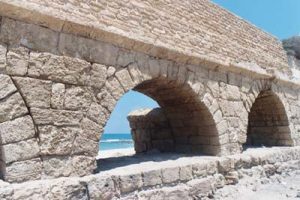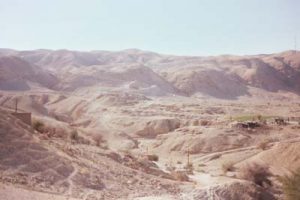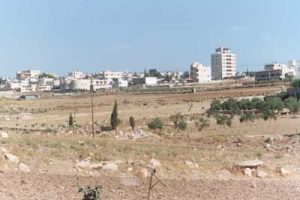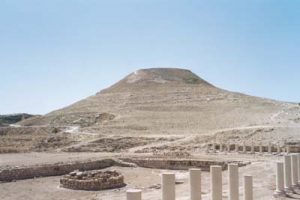by Pastor Ed Visser
At Caesarea there was a man named Cornelius, a centurion in what was known as the Italian Regiment… The following day Peter arrived in Caesarea. Acts 10:1, 24
When the cavalry arrived in Caesarea, they delivered the letter to the governor and handed Paul over to him.… Then he ordered that Paul be kept under guard in Herod’s palace. Acts 23:33, 35
Caesarea–by–the–Sea (Maritima) was a purely Roman city. Built by Herod on the sandy coast of the Mediterranean, it was a city dedicated to Caesar Augustus and became an important seaport for Roman ships. Since there was no natural port on Israel’s coastline, Herod made one from scratch, using some newly invented cement that dried underwater, one of Herod’s greatest feats.
 Since there was no fresh water in the area, Herod also constructed seven miles of aqueduct, which brought water from Mt Carmel. He also equipped Caesarea with all the accoutrements of a Roman city: amphitheater, a hippodrome for horse races, and a huge theater conveniently located near the palace. A large temple, also in honor of Augustus, greeted the ships sailing into the harbor, apparently the first thing one saw from the sea.
Since there was no fresh water in the area, Herod also constructed seven miles of aqueduct, which brought water from Mt Carmel. He also equipped Caesarea with all the accoutrements of a Roman city: amphitheater, a hippodrome for horse races, and a huge theater conveniently located near the palace. A large temple, also in honor of Augustus, greeted the ships sailing into the harbor, apparently the first thing one saw from the sea.
Herod also built himself a palace, which stood on a promontory jutting out into the Mediterranean with its requisite Herodian pool. Herod could swim in fresh water while watching Roman ships sail in across the sea. The base of the palace and swimming pool are still visible today. Since the city  became the capital of Judea, this would be where Herod, his sons, and later governors of Judea would spend most of their time. Pilate also lived here, and a stone with his inscription was actually found in the reconstruction of the Caesarean theater.
became the capital of Judea, this would be where Herod, his sons, and later governors of Judea would spend most of their time. Pilate also lived here, and a stone with his inscription was actually found in the reconstruction of the Caesarean theater.
Despite not being a very Jewish city, Caesarea does become the stage for a couple of events in the book of Acts. It was Caesarea where the first Gentile convert of the early Christian church lived, a Roman soldier by the name of Cornelius. The Apostle Peter was actually summoned to this city to lead him and his family to faith in Jesus Christ, and here, in this Roman city, the Holy Spirit was first poured out on Gentiles.
 The man who would make it his life’s calling to reach out to more Gentiles, the Apostle Paul, sailed in and out of this port on his missionary journeys — the last time on his way to Rome itself. Paul was arrested in Jerusalem, but when word of a Jewish plot to kill him surfaced, the Roman guard had him transported to the capital city of Caesarea for a “change of venue.” Paul was actually imprisoned in what was still called Herod’s palace (although I doubt he had use of the pool!). Though a thoroughly Roman city, even Caesarea played a crucial role in New Testament history. Might the sovereign God continue to use pagan cities of this world to fulfill his purposes?
The man who would make it his life’s calling to reach out to more Gentiles, the Apostle Paul, sailed in and out of this port on his missionary journeys — the last time on his way to Rome itself. Paul was arrested in Jerusalem, but when word of a Jewish plot to kill him surfaced, the Roman guard had him transported to the capital city of Caesarea for a “change of venue.” Paul was actually imprisoned in what was still called Herod’s palace (although I doubt he had use of the pool!). Though a thoroughly Roman city, even Caesarea played a crucial role in New Testament history. Might the sovereign God continue to use pagan cities of this world to fulfill his purposes?



 One of the places I was able to visit while in Israel was the “little town of Bethlehem.” I say this with gratitude because, despite all the peaceful scenes of Bethlehem on our Christmas cards, today it is often a place of strife, off limits to tourists.
One of the places I was able to visit while in Israel was the “little town of Bethlehem.” I say this with gratitude because, despite all the peaceful scenes of Bethlehem on our Christmas cards, today it is often a place of strife, off limits to tourists.
